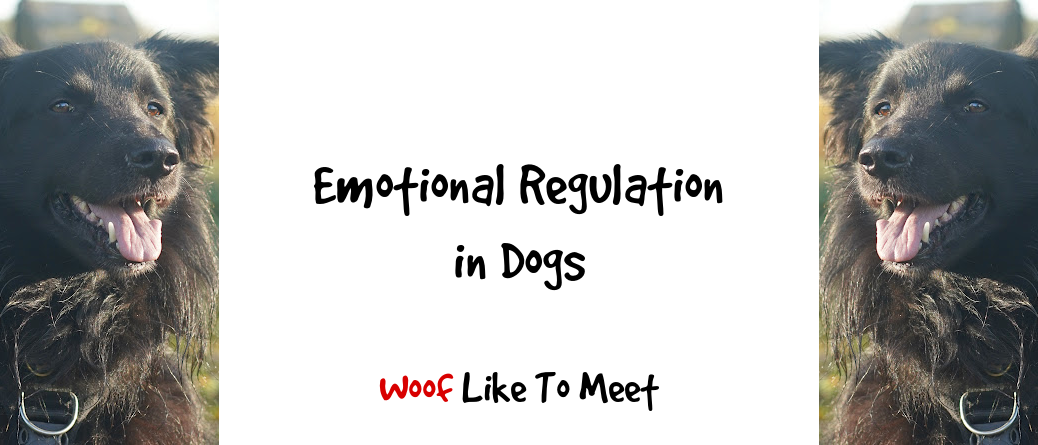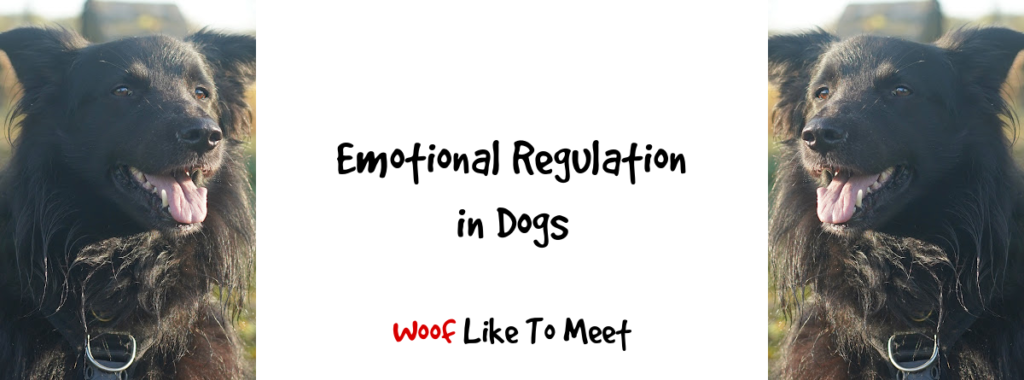In the last six months or so, there’s been an increasing amount of talk in the dog world about emotional regulation in dogs.
It’s not a term that many people have really sat down and thought about. As a result, it runs the risk of being just another buzzword. Some trainers have already started using it as a synonym for impulse control. This seems to be because they don’t like to use the word ‘control’, perhaps because it smacks of coercion and force. This is sad because they’re just dressing up fairly coercive practice in buzzwords, hoping that they’ll somehow magically become more positive.
Other trainers have jumped on this trendy buzzword and taken it to mean things like dogs learning rule structures and complying with human requests or commands. Sitting nicely and being calm or coping in a crate for hours on end are sometimes erroneously taken to be examples of how dog trainers are ‘teaching’ dogs self-regulation strategies. This is not teaching puppies how to regulate their emotions: it is using control to manage developing animals and ignoring their needs.
If you’re a dog trainer starting to throw this term into your work, have a read of this before you go any further. If you’re a guardian, this article should help you understand this crucial skill for dogs.
Emotional regulation in animals is actually not that well defined. It’s been relatively well defined in children in recent years and it’s no doubt the fact that it is the latest buzzword in Early Years education in the UK that’s driving dog trainers to pick up on the trend. For that reason, I’ve been picking the brains of my former colleagues in Early Years training in the UK to help me get my head around it. We were ably assisted by a post-doc educator who teaches through opening up her students’ eyes to the world around us and who could help translate a concept meant for human development into more general principles about other species. I have to say that as a result of these weekly conversations, my mind has well and truly been blown. Humans are such a young species: we could do with watching and listening the world around us a little more, that’s for sure!
So what is regulation? Self-regulation is an individual’s ability to moderate their own energy levels, emotions, behaviours and attention in ways that are socially acceptable.
What might that look like in dogs?
Managing energy levels
One thing is knowing when you’re tired and you need to put yourself to bed. My boy Heston has always been very good at putting himself to bed in the bedroom when he’s had enough. Around about 7pm, he wanders off to the bedroom and puts himself to bed.
Another way might be a dog who interrupts play. We can’t know that dogs consciously interrupt play because things are getting too much. But we do see dogs self-interrupting when things get a little too arousing.
I’m going to share here one of my favourite videos of Heston with a young puppy. She was 8 weeks old. I’d had to separate her from her siblings because she was not able to interrupt her play and manage her energy levels. She was biting her siblings very hard. They were squealing and it was becoming more and more intense. Here, she’s playing with Heston who knows how to help her manage her energy levels without letting her get too over-aroused:
What you can see is that as she gets more intense, Heston stops play politely, gets up and disengages.
What he’s doing, in other words, is managing his own energy levels. In fact, I’d argue that just like any good uncle, he’s helping her learn to manage her emotions as well. It is one of his most magnificent skills.
Managing emotions
Self-regulation is also about managing our own emotions. This is where it gets complex for dogs because the first step of managing your emotions is recognising that you’re having them and then taking steps to acknowledge them, accept them and decide whether or not to behave as they’re directing you to.
Let’s just be clear: humans are not very good at this all the time. Young children are not very good at this. Tantrums are a perfectly normal example of how difficult it can be to manage your emotions. Teenagers are also not particularly good at this. I’m reminded of that scene in The Lost Boys where, when Jason Patric sees Jami Gertz and starts following her through the fair, Corey Haim playing his younger brother badgers him into admitting he’s chasing her: ‘I’m at the mercy of your sex glands, bud!’
Also, given the current state of social media, adult humans are also not particularly good at managing their emotions either. Recognising what’s pushing your buttons, what’s driving you and then managing it seems to be beyond a whole heap of people.
Is now a good time to admit I’m on a 12-hour temporary Twitter ban for calling an MP a made-up rude word?
None of us are angels on that score, I bet.
It’s tough to know whether dogs recognise their own emotions. As ethologist Frans de Waal might remind us, it’s very hard to test whether they do.
As my educator friend would say, though: What Do You See?
Well, I see dogs who moderate their bites in anger ALL the time.
Not a day goes by when I don’t work with dogs who have bitten. That’s my speciality. One of the hardest things for guardians to accept is that there was actually a whole heap of emotional management in the bite. Even dogs who fight usually exhibit a whole heap of restraint. That restraint is my evidence of emotional management. Inhibition is a very good indicator that animals are regulating their emotions. Whenever you see a dog inhibit their response, that for me is evidence that they can and do regulate their emotions.
Just as an example, Lidy doesn’t particularly like it if she’s resting and I touch her foot by accident or I move a bit. She usually hops off the couch, jumps back on again and repositions herself further away. For me, what I see is a dog who is irritated by my clumsy behaviour and who, instead of biting me in the face and killing me, chooses to get up, reposition herself and de-escalate the situation. My emotional dog handling her emotions a whole lot better than many of us on social media….
Managing behaviour
Physiology, emotions and behaviour are a big, tangled knot. They are each other. Physiology is behaviour and behaviour is physiology. It’s a bit difficult to separate out those three concepts from each other.
That’s why in managing her irritation, my dog Lidy then manages her own behaviour.
We see this all the time in restraint and behavioural inhibition.
A fairly regular occurrence in my house is that Heston will spend 7pm onwards stretched out on my bed. When Lidy and I go to bed, he’ll often get off the bed and go in his own bed. Sometimes, however, he stays on the bed. He’s a pretty big dog and my bed is small. Lidy alters her behaviour around him. Usually, if he’s not on the bed, she’ll jump right up and lie down. There’s plenty of energy in her jump and she usually does it the moment we go into the bedroom.
Yet if Heston is on the bed, she’ll usually sit and wait. She’ll look at him patiently, look at the space left, look again, stand up, put her front paws up tentatively, sit back down again, maybe stand up and turn in a circle. Only when she can see that a) he isn’t going to move and give her the whole bed and b) he’s not going to have any issue letting her up will she then hop onto the bed. It’s a beautiful, communicative dance.
He does the same back to her if she is on the couch and he wants to get up. He’s so tentative and restrained. Whenever dogs manage themselves in turn-taking, they are regulating their behaviour.
When my friend asks What Do You See? I see dogs modulating and modifying the intensity of their behaviour.
Managing attention
Another feature of self-regulation is managing your attention. One thing that is fairly common in Early Years scenarios is that young children find it hard to focus their attention in distracting environments. As we grow up, we sometimes get better at doing this, but it very much depends on the intensity of those distractions. I find it very hard, for instance, when there are significant events happening around the world not to check in on news sites regularly. I find it hard to manage where my attention goes if I’m hungry or if I’m tired. If the topic hasn’t truly grabbed me, I find it hard to keep paying attention to it. I’m supposed to be writing some stuff about learning and memory right now but it’s not as interesting as this regulation butterfly I’m chasing, so here I am.
We ask dogs to manage their attention all the time. That can be hard as it involves complex cognitive processes such as executive function and working memory. Have you ever thought for a single second how hard it is for assistance dogs and service dogs and working dogs to *not* go off and do this:
Managing our attention means being able to prioritise. It means being able to manage multiple tasks and do a number of things at the same time. It means decision making. It also means being able to ignore things and turn off distractions.
About emotional regulation
So far, I’ve been writing about self-regulation, something that Early Years educators expect young children to be in the process of acquiring if they fit average human age + stage developmental milestones. It’s not something we’re born with. Nor is it one-size-fits-all.
A very large number of humans do not fit this ‘average’ mould as children or as grown-ups.
What’s hard is seeing just how many humans expect dogs to be able to manage their energy levels, emotions, behaviour and attention to higher standards than we expect of our own species. You know, the species with the large bits of the brain dedicated to helping us regulate ourselves.
It’s also really, really hard to see just how many humans expect very young dogs to simply know how to self-regulate.
We’re not born with the ability to regulate ourselves. Neither are puppies. Regulation is a developmental process if our bodies conform to some kind of average. It’s frequently thrown off course by hormonal changes and neurodevelopmental changes. It’s even thrown off course if we’re tired, stressed or hungry. If you’ve ever clenched your fists because someone was going slowly or you’ve ever thought to yourself, ‘Come on!’ when someone is taking too long at the checkout, you know how very easy it is for our ability to self-regulate to be thrown off course. Yesterday, I spent the day a bit agitated because my socks were too tight and I had a fat hair bobble in because I couldn’t find my skinny hair bobbles and it didn’t hold my hair in place satisfactorily and there may have been hormonal influences at work as well and it was also a bit windy and my couch just didn’t seem comfortable like normal and…
You get the picture.
Dogs’ ability to regulate is developmental as ours is. It is also subject to neurobiological changes, hormonal changes and the effect of the environment around us.
For humans, learning to self-regulate is important. It helps us learn to be resilient, to be tenacious, to cope with frustration, to be patient. It stops us all ending up in prison. It helps us manage stress and protects us from chronic long-term stress. It allows us to make friends, to form attachments, to be empathetic and compassionate.
The same things are true for dogs. Like young children, dogs are natural explorers. They are movers. Their learning is embodied. What that means is that learning things like ‘sit’ aren’t simply cognitive concepts, they are physical. They involve the body. Dogs are active learners. This is especially true of young dogs, whom we often expect to regulate their bladders, their bowels, their vocalisations, their actions, their needs to an incredibly high level at an incredibly young age.
What we need to remember is that babies of all species rely on their parents to regulate for them. Puppies can’t even regulate their own body temperature. As they develop, social mammalian species rely on adults to assist them. This process is called co-regulation and it has much more relevance for our dogs.
Co-regulation occurs as individuals move from dependence to independence. We get support from the social group in order to help manage our energy levels, our emotions, our behaviour and our attention.
How many parents out there are furious at the grandparents for sending home a child hopped up on sugar, a child who hasn’t had their afternoon nap? Young children rely on adults to help them manage their energy levels. Pre-schoolers don’t put themselves to bed when they’re tired, do they? They don’t help themselves from the fridge when they’re hungry? Even if you’re a parent who used structures like baby-led weaning to help your child move to independent food choices, it’s not entirely baby-led, is it? I mean, you don’t let your baby pick out everything they’d like in the supermarket? Which parent lets their child do the shopping? I know some of my friends don’t let their husband do the food shopping! If you give someone a shopping list, that is in itself a form of regulation.
Like young children, young dogs are still learning about their bodies, their likes, their dislikes, things that scare them, things that are fun. They’re learning how to behave.
What we can’t do as responsible, social beings, is leave this entirely up to the puppy. The development of social individuals is a social process. It’s the whole point of parenting for the first few developmental points and then it requires wider social structures. Developing individuals of any social species learn how to make friends, how to accept others, how to resolve conflict successfully. They learn coping strategies that help them deal with disappointment, with frustration or with anger. They learn about their bodies and how to use them. They learn how to care for others and how to enjoy life. They learn to laugh, to relax, to play.
To assume that these just happen is to misunderstand the whole point of being a social species; these skills do not develop in isolation and they are all highly individual. We all have individual developmental needs where the guidance of adults helps make up for our personal deficits and our weaknesses, scaffolding our attempts to become a functioning individual.
As with everything in life, it’s always a fine balance: the balance between prescriptive and permissive guidance, the balance between individual needs and societal expectations, the balance between immediate and delayed gratification. It’s our job as trainers and as guardians to help our dogs with this, not expect them as if by some universal magic to develop these skills without familial and social support.
In the next few posts, we’ll be looking at puppy development and behaviour. We’ll look at developmental transitions. We’ll consider what happens when regulation fails. We’ll alsco consider ways in which we can help our dogs learn the skills they need to be members of their own species as well as members of interspecies social groups. We’ll explore the importance of predictable, consistent routines and clear boundaries for emotional security and safety, as well as ways we can create environments in which our dogs can flourish. All this will mean listening to our dogs’ needs, acknowledging their feelings and valuing them as individuals as well as creating a supportive environment in which they can flourish.
Don’t forget to sign up for emails if you want these delivered to your inbox, and follow Woof Like To Meet on Facebook. I’m in the process of pre-launching (is this a thing??) Lighten Up Dog Training, focused on helping dogs with the practicalities of regulation. It won’t be fully live in all its facets until September, but we depend on you to help us grow.
Dog trainers: my book to help you move to a more client-centred, less coercive and more cooperative approach is available from Amazon in e-book and paperback format.



